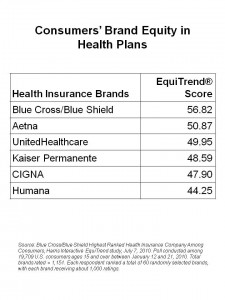
 Health insurance companies aren’t the most beloved stakeholder in health in America these days, based on polls from J.D. Power, HarrisInteractive, and Gallup, among many others. Nonetheless, within the category, it’s good to be #1, and when it comes to health plan brand equity, it’s good to bear Blue Cross/Blue Shield branding in 2010.
Health insurance companies aren’t the most beloved stakeholder in health in America these days, based on polls from J.D. Power, HarrisInteractive, and Gallup, among many others. Nonetheless, within the category, it’s good to be #1, and when it comes to health plan brand equity, it’s good to bear Blue Cross/Blue Shield branding in 2010.
This finding comes from Harris Interactive’s EquiTrend study on health plan branding, where brand equity is a metric built on U.S. consumers’ perceptions of familiarity, quality, and purchase consideration.
After being Blue, Aetna and United follow in second and third brand rankings.
The survey was conducted in January 2010 among 19,708 U.S. consumers ages 15 and over. A total of 1,151 consumer-facing brands were considered overall, within and beyond the health insurance category. Each respondent ranking 60 randomly selected brands. Each brand ranked received about 1,000 ratings which in aggregate provided the score.
Health Populi’s Hot Points: Consumers don’t always have a choice when it comes to buying health insurance: if one’s employer sponsors health insurance as an employee benefit, then the choice is largely determined by the human resource/benefits department. However, as more uninsured Americans come into the insured fold through the implementation of the Patient Protection and Affordable Care Act (PPACA), local plan branding will be a key to being a successful health plan marketer.
The Blues have a long history of being ‘local ‘ in their markets, with the overall Blues’ branding providing a national banner-brand. New-to-market health consumers will shop for health insurance based on price and benefit packages, but branding will certainly play into this mix. Questions such as “what plan can I trust?” and “who knows my local health market?” will come to the plan-shopper’s decision scenario. Welcome, health plans, to the new retail health scene.




 Interviewed live on BNN Bloomberg (Canada) on the market for GLP-1 drugs for weight loss and their impact on both the health care system and consumer goods and services -- notably, food, nutrition, retail health, gyms, and other sectors.
Interviewed live on BNN Bloomberg (Canada) on the market for GLP-1 drugs for weight loss and their impact on both the health care system and consumer goods and services -- notably, food, nutrition, retail health, gyms, and other sectors. Thank you, Feedspot, for
Thank you, Feedspot, for  As you may know, I have been splitting work- and living-time between the U.S. and the E.U., most recently living in and working from Brussels. In the month of September 2024, I'll be splitting time between London and other parts of the U.K., and Italy where I'll be working with clients on consumer health, self-care and home care focused on food-as-medicine, digital health, business and scenario planning for the future...
As you may know, I have been splitting work- and living-time between the U.S. and the E.U., most recently living in and working from Brussels. In the month of September 2024, I'll be splitting time between London and other parts of the U.K., and Italy where I'll be working with clients on consumer health, self-care and home care focused on food-as-medicine, digital health, business and scenario planning for the future...